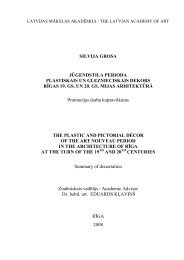Institute of Art History of the Latvian Academy of Art Anna Ancāne ...
Institute of Art History of the Latvian Academy of Art Anna Ancāne ...
Institute of Art History of the Latvian Academy of Art Anna Ancāne ...
Create successful ePaper yourself
Turn your PDF publications into a flip-book with our unique Google optimized e-Paper software.
manifestations <strong>of</strong> different styles (Jurijs Vasiļjevs), researches <strong>of</strong><br />
construction histories <strong>of</strong> particular objects (Roberts Malvess, Rūdolfs<br />
Šīrants, etc.). In <strong>the</strong> 1970s innovative publications appeared on <strong>the</strong> types<br />
<strong>of</strong> Old Riga’s dwelling houses in 16 th – 17 th century and Riga’s structure<br />
<strong>of</strong> architecture and urban planning during <strong>the</strong> Baroque period (Rita<br />
Zandberga), in <strong>the</strong> 1980s – <strong>the</strong> monograph by Gunārs Zirnis on St. Peter’s<br />
Church. In <strong>the</strong> Soviet time such architects as Edgars Pučiņš, Jānis<br />
Krastiņš etc. have taken up <strong>the</strong> architecture <strong>of</strong> Riga in <strong>the</strong> 17 th century.<br />
During <strong>the</strong> last decades several publications appeared on this subject<br />
(Ojārs Spārītis, Jānis Krastiņš); in-depth analyses <strong>of</strong> Riga’s plan and<br />
fortification system were carried out (Ieva Ose, Margarita Barzdeviča).<br />
The latest editions have paid attention also to <strong>the</strong> planning development<br />
<strong>of</strong> Riga’s suburbs (Irēna Bākule, Arnis Siksna). The most thorough<br />
researches <strong>of</strong> interaction in <strong>the</strong> fields <strong>of</strong> art and urban planning between<br />
<strong>the</strong> 17 th century Baltic countries and Sweden were initially done by Sten<br />
Karling but in our days – by Nils Ahlberg. Dutch art historian Konrad A<br />
Ottenheym and German architect Hans-Gün<strong>the</strong>r Griep have also dealt<br />
with <strong>the</strong> phenomena <strong>of</strong> Riga’s late 17 th century architecture in <strong>the</strong><br />
European context. Still no systematic survey exists so far. The<br />
architectural history <strong>of</strong> Riga in <strong>the</strong> 2 nd half <strong>of</strong> <strong>the</strong> 17 th century, based on<br />
<strong>the</strong> research <strong>of</strong> all available materials, had not been written yet.<br />
7. The structure <strong>of</strong> <strong>the</strong> PhD <strong>the</strong>sis<br />
Results <strong>of</strong> research are related in <strong>the</strong> text <strong>of</strong> doctoral dissertation<br />
consisting <strong>of</strong> an introduction, six main chapters, conclusion and appendix<br />
with 416 images. The first chapter includes <strong>the</strong> historical overview <strong>of</strong><br />
Riga’s architecture up to <strong>the</strong> 2 nd half <strong>of</strong> <strong>the</strong> 17 th century; this is necessary<br />
to understand better <strong>the</strong> regularities <strong>of</strong> architectural processes in <strong>the</strong> next<br />
period. The second chapter deals with <strong>the</strong> urban planning <strong>of</strong> Riga in <strong>the</strong><br />
17 th century, including <strong>the</strong> structure, fortifications, street network<br />
description as well as <strong>the</strong> analysis <strong>of</strong> plans and panoramas <strong>of</strong> Riga <strong>of</strong> <strong>the</strong><br />
time. The third chapter focuses on <strong>the</strong> innovations in <strong>the</strong> architecture <strong>of</strong><br />
public buildings, but <strong>the</strong> fourth chapter – on typological issues <strong>of</strong><br />
dwelling houses and innovations in <strong>the</strong>ir construction. The fifth chapter<br />
reveals <strong>the</strong> characterisation <strong>of</strong> architectonic finish and décor <strong>of</strong> Riga’s<br />
buildings, but <strong>the</strong> sixth chapter analyses <strong>the</strong> architecture <strong>of</strong> Riga in <strong>the</strong><br />
context <strong>of</strong> foreign influence routes and analogies. The PhD <strong>the</strong>sis is<br />
completed by conclusions.<br />
I. INSIGHT INTO RIGA’S ARCHITECTURAL HISTORY UP TO<br />
THE 2 ND HALF OF THE 17 TH CENTURY<br />
I. 1. Urban development <strong>of</strong> medieval Riga<br />
The structure <strong>of</strong> Riga’s medieval layout took shape over a long period <strong>of</strong><br />
time since <strong>the</strong> late 12 th century. The stabilisation <strong>of</strong> street network<br />
5












